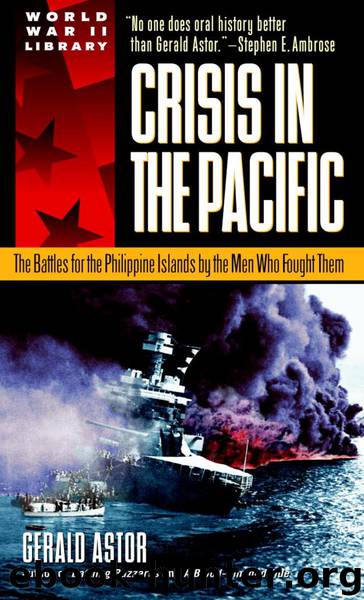Crisis in the Pacific by Gerald Astor

Author:Gerald Astor [Astor, Gerald]
Language: eng
Format: epub
ISBN: 978-0-307-56565-5
Publisher: Random House Publishing Group
Published: 1996-01-30T05:00:00+00:00
THROUGHOUT THE CAMPAIGNS that involved the Solomons, Marshalls, Marianas and the New Guinea locale, MacArthur and Nimitz cooperated without serious disagreement about objectives while occasionally squabbling over allocation of resources. But as enemy-controlled areas shrank, Army and Navy top brass debated whether some former targets might be bypassed. Instead of invading the Philippines, some policy makers, including Chief of Naval Operations Ernest J. King, suggested the Japanese forces in the archipelago be left to wither on the vine while combined operations plucked Formosa or even struck directly at the home islands. Not so innocently, the options of Formosa and the home islands fell within the purview of the naval authorities; the Philippines lay in MacArthur's fief.
MacArthur lobbied strongly for occupation of the Philippines. “The Philippine Islands had constituted the main objective of my planning from the time of my departure from Corregidor,” he said later. “As the Allies advanced westward along New Guinea and across the Central Pacific, a wide divergence of opinion developed among international planners and military strategists as to the methods of defeating Japan, but I never changed my basic plan of a steady advance along the New Guinea-Philippines axis, from Port Moresby to Manila.”
He advised the Joint Chiefs that bypassing the Philippines would be a military mistake and would entail tremendous loss of prestige in the Far East. General Marshall responded that MacArthur should not allow his personal feelings about the Philippines nor his concern for politics in the area interfere with the top priority, winning the war. He remarked that “bypassing” was not synonymous with ‘ ‘abandonment.'’
Closer to the scene than Admiral King or General Marshall, Navy leaders like Adm. William Halsey, head of the 3rd Fleet, recognized that without some base in the Philippines, moves against Formosa or Japan itself would be highly risky.
Nevertheless, with the war approaching its third anniversary, the Joint Chiefs in the summer of 1944 searched for a plan to accelerate the pace. Without committing themselves to taking back Luzon, the Navy agreed that for a start it would be necessary to capture southern and central Philippine areas. Mindanao, vulnerable since the conquest of Wakde, Biak and Noemfoor, seemed ripe for the opening thrust, and then Leyte, strategically sited in the middle of the islands. A tentative schedule was set with November 1 as the date for landings on Mindanao.
During the first two weeks of September, carriers from Halsey's fleet launched a series of preparatory strikes on Mindanao and the central islands. Halsey now reported to Nimitz that his pilots had destroyed the Japanese fuel supplies, sunk almost all visible vessels and encountered few aircraft. Most significantly, a downed flier rescued by Filipinos brought back the startling intelligence that there were no Japanese soldiers on Leyte. Halsey recommended that the combined forces attack Leyte instead of Mindanao.
Even as Halsey radioed his findings, the Navy carried out landings in the Palaus, due east of Mindanao and Leyte. For all of the naval talk about the virtues of skipping over a possible
Download
This site does not store any files on its server. We only index and link to content provided by other sites. Please contact the content providers to delete copyright contents if any and email us, we'll remove relevant links or contents immediately.
| Africa | Americas |
| Arctic & Antarctica | Asia |
| Australia & Oceania | Europe |
| Middle East | Russia |
| United States | World |
| Ancient Civilizations | Military |
| Historical Study & Educational Resources |
The Radium Girls by Kate Moore(11896)
100 Deadly Skills by Clint Emerson(4821)
Rise and Kill First by Ronen Bergman(4678)
The Templars by Dan Jones(4613)
The Doomsday Machine by Daniel Ellsberg(4395)
The Rape of Nanking by Iris Chang(4123)
Killing England by Bill O'Reilly(3936)
Hitler in Los Angeles by Steven J. Ross(3889)
Stalin by Stephen Kotkin(3861)
12 Strong by Doug Stanton(3492)
Hitler's Monsters by Eric Kurlander(3256)
Blood and Sand by Alex Von Tunzelmann(3118)
Darkest Hour by Anthony McCarten(3054)
The Code Book by Simon Singh(3049)
The Art of War Visualized by Jessica Hagy(2929)
Hitler's Flying Saucers: A Guide to German Flying Discs of the Second World War by Stevens Henry(2697)
Babylon's Ark by Lawrence Anthony(2554)
The Second World Wars by Victor Davis Hanson(2466)
Tobruk by Peter Fitzsimons(2430)
